Shiftless. Clutchless. Stepless. Seamless. Clueless? This just in: The idea of a transmission that picks the perfect ratio is hardly a new one. A particularly bright guy by the name of Leonardo da Vinci cooked up the concept of a continuously variable transmission in 1490. With a few notable exceptions-the 1910 Zenith V-2, 1976 Moto Guzzi Convert and 1978 CB750A Hondamatic, to name a few-most modern motorcycles expect us to shift for ourselves. Most, that is, except for the Aprilia Mana 850 and Honda DN-01. And while the purist contingent may argue whether the plastic-wrapped DN-01 is actually a motorcycle at all, one look tells you it's about as far from the Mana as Aprilia's Noale headquarters are from Honda's in Tokyo.
The home office calls the DN-01 a hybrid-a bridge over the horse latitudes separating motorcycling and scooterdom. Ambiguous? Yes, but it fits. And just to set the record straight, DN-01 is Honda shorthand for Dream New Concept One. It debuted with Honda's other blue-sky concepts at the 2005 Tokyo Motor Show, framing the then-new Human Friendly Transmission, designed to maintain perfect engine speed at your chosen rate of travel via a staggeringly crafty fusion of electronics and hydraulics. No big thing, really-we're used to Honda engineers coming up with bright ideas. Two years later, it was part of Honda's '08 European lineup-very big surprise. And this year, it showed up here. Don't swallow your gum.
The DN-01 parts manifest is a predictably eclectic mix. Judging by the exterior, there should be a hydrogen fuel cell in there somewhere, or a lithium-ion battery pack. Not this time: Derived from Honda's painfully sensible NT700V Deauville Euro-tourer, the humble 680cc V-twin generates power, sending it through a CVT transmission and shaft final drive. Start the engine, switch from neutral to drive and it does the rest. Another bar-mounted switch cues up Sport mode if you're in a hurry. A tiny trigger on the throttle side cues up Manual mode, which lets you thumb through six preset ratios. A plain old pipe-rack steel frame holds everything together atop sporty 17-inch wheels, fitted with reassuringly large rotors and triple-piston Nissin calipers. Once you initiate the deceleration process, Honda's Combined Brake System and excellent ABS help insure drama-free stopping on any sort of pavement. Wrapped in edgy plastic blending hints of NR750 with Romulan Attack Cruiser, the '01's seat is low enough to accommodate the vertically disadvantaged behind that steeply raked windscreen. But floorboards? Sure: It's a "sport cruiser," remember?
Despite its scooter-spec powertrain and more practical, commuter-spec accoutrements, the Aprilia looks like ... well, a motorcycle. Aside from the oddly shaped covers camouflaging various parts of its more conventional belt-driven CVT paraphernalia, it could pass for a mid-sized naked Italian V-twin because that's mostly what it is. The Italian orthodox steel-trellis frame is similar to that of Aprilia's Shiver 750. Its 17-inch wheels wear big disc brakes and radial-mount ersatz Brembo calipers. But the SOHC, eight-valve, 839cc V-twin and that CVT transmission are a more advanced version of what you'll find under the skin of a Gilera GP800 scooter-one of the perks that come with life under the Piaggio Group's corporate umbrella. Here's another infusion of scooter-spec practicality: a lockable full-face-helmet-sized storage bin where the fuel tank should be. When the low-fuel light comes on at 130 miles or so, you'll find that unleaded lives in a 4.2-gallon tank under the seat. Topped off and ready for action, the Mana tips the scales at 516 pounds, which sounds heavy until you find out the Honda weighs 605 lbs. wet.
Technology can be weighty stuff, but swoopy plastic is very slimming. Still, the DN-01 never feels that heavy, despite chassis numbers that are only slightly sportier than a Harley-Davidson Super Glide's. Cruiser types will love the 27-inch seat height, rearward-reaching bars and cruiser-style floorboards. Tall types will be less enthusiastic about the odd, urban-slouch riding posture. At least the LCD instrument display is nice-if that steeply angled windscreen doesn't block your view.
Agile, it isn't. But thumb that rocker switch on the right bar to engage Drive mode, feed in a whiff of throttle and the '01 flows into motion with digital precision. Modern V-belt automatics are good-and Aprilia's is better than most-but Honda's electro-hydraulic masterpiece makes the best of them feel old and vaguely agricultural. Roll on the throttle and revolutions per minute become miles per hour with a smoothness usually reserved for electric motors and 18-year-old Kentucky Bourbon. In Drive mode, transmission electronics keep the engine spinning close to its 6000-rpm torque peak. Whack the throttle and it takes a second or two for your ground speed to sync up with the exhaust note. That's a familiar phenomenon to outboard motor operators, but something of a disconnect to those more accustomed to manual-transmission motorcycles.
Switch to Sport mode and the HFT accelerates forward process with a longer rpm leash-handy for dispatching four-wheeled laggards and locating the 7500-rpm rev limit. It's less efficient in the mpg department, and acceleration is exactly what you'd expect from 42.4 horsepower pushing 605 pounds: adequate, as in faster than most four-wheeled vehicles and way faster than the 18-wheel variety. Overcome by analog nostalgia? Shift through the six virtual ratios at will, but the human-friendly circuits won't help your Rubens Barichello impression. Upshifts are solid and reasonably quick, but the ECU enforces slow, methodical progress back toward first. Should you forget to cue up first at that next stop sign, Honda's electronic elves will do it for you.
Off The Record
Tim Carrithers, Executive Editor
Age: 50
Height: 6'3"
Weight: 210 lbs.
Inseam: 35 in.
If the Honda is a transmission in search of a motorcycle, the Aprilia is a motorcycle in search of a transmission. The Mana wins any practicality contest, but real motorcyclists will notice something's missing in the same way real Italians miss something in deodorized garlic oil. Heart. Soul. A reason to get out of bed on Saturday morning.
There is no truth to the rumor that DN-01 is Honda dealer shorthand for "Do Not Order One." My friends in the business swear some dealers are selling every DN-01 they can lay their sweaty palms on. Sure. Looking for something to defibrillate the Segue poseurs at this year's Seizure World Bocce Ball Pro/Am? This would be it. Otherwise? Prepare to be underwhelmed. Besides, I already have a shiftless Honda grocery-getter at home: my '72 Trail 70. Cost me all of $300.
A viable automatic needs to shift at least as well as I can. The DN-01 succeeds on that count, but that pear-shaped power-to-weight ratio renders the HFT functionally irrelevant. If that doesn't push you over the edge, the $15,599 sticker price will. That's $94 more expensive than a Honda Civic.
Once you quit reaching for the clutch lever that isn't there, crack the central dash pod's Italian pretzel-logic and get down to business, Aprilia's Sportgear system is as easy as frozen Tiramisu. Twist the throttle and go. Though it can't match the Honda's fluid precision, and engine speed takes longer to catch up with the speedometer pulling away from a light, the computer-controlled, belt-drive CVT does a fine job of turning those 40 lb.-ft. of torque into thrust. More modes inject some confusion at first. Set off in Autodrive and you have your choice of three electronic maps: Touring, Sport and Rain. Sport generates a bit more sporting acceleration while Rain filters all the fun out of it, which makes Touring our pick for shiftless travel. Autodrive allows manual downshifts as long as you're not on the gas. In Manual mode, you move up or down through the seven virtual ratios via a pair of adjacent switches on the left bar or another switch disguised to look like a conventional shift lever. Either way, virtual shifts take longer on the Mana. It's marginally quicker in Manual mode, and there's a bit more engine braking than Autodrive can muster. Otherwise, holding a given ratio longer than the computer would produces more noise and vibration than anything else.
Honda's twin is smoother. On the flip side, it makes the Mana feel more like Max Biaggi's RSV4 World Superbike than a 55-horse commuter twin. Covering a quarter-mile of asphalt in 13.5 seconds, the Mana isn't what we'd call fast, but it is more than a second quicker than the heavier, less powerful Honda. Aside from its less capable brakes, the Mana delivers superior sporting performance regardless of how or where you measure it. Soft springs in the non-adjustable fork allow more chassis pitch than we'd like when you're hard on the brakes, and the sidestand drags prematurely in left-handers. No matter: The Honda's long wheelbase, lazy steering geometry and more limited cornering clearance add up to an unwilling sporting companion. On any stretch of twisty road, the Aprilia is like bringing a GAU-8 Gatling gun to a knife fight: no contest.
On the freeway, conventional ergonomics and a whole lot more legroom make the Mana a better choice for covering a few hundred miles. Fuel stops are 135-165 miles apart if you're careful versus the Honda's 110-135. And after assuming the DN-01's torturous ergonomics for 135 uninterrupted miles, you won't want to do it again. Both bikes are better suited to short hops than the long haul, but the Mana is much more receptive to bags and a small fairing than the Honda, which comes with exactly enough storage space for its owners manual and a pathetic excuse for a tool kit.
Despite differences outnumbering similarities, both bikes are aimed at someone who wants something that goes, stops and turns better than the average scooter, but doesn't want to deal with a conventional motorcycle clutch and gearbox-something of a minority in American showrooms, if our informal polling data is worth the cocktail napkins it's written on. If they pay any attention at all, those who have the clutch thing down will only notice the Mana if it's blocking their view of a Shiver or Dorsoduro.
Sexy? No: The Mana is a practical, versatile motorcycle that just happens to have an automatic transmission, while the DN-01 is an absolutely brilliant automatic transmission trapped in a cryptic design exercise. It's a rare piece, and interesting enough to draw a crowd, even in the technology-soaked gas stations of Southern California. But said crowds evaporate faster than spilled unleaded in July when you mention the Honda's $15,599 price of admission-$5700 more than the Aprilia. Two pumps down, the Mana attracts a different kind of attention: Some guy in a minivan wonders why you're pumping gas under the passenger seat while the H-D Softail lady wants to know how you're getting home without a clutch lever. It's certainly not for everybody, but seen through the right set of eyes, the Mana is almost beautiful.
Off The Record
Brian Catterson, Editor-In-Chief
Age: 47
Height: 6'1"
Weight: 215 lbs.
Inseam: 34 in.
As long as I've worked at motorcycle magazines (21 years now), I've tried to ride each and every testbike. Tough job, I know, but it's not easy when we're conducting multiple comparison tests simultaneously.
When these two automatics showed up, I was embroiled in our August issue's "Summer of Love" chopper comparo. Until late one night, when I'd had enough "chopperflop" negotiating the mean streets of Hell A, I threw a leg over the Mana-and didn't get off it for two weeks.
While I've always appreciated the utilitarian aspect of scooters, there's a stigma attached. Not so the Mana: It's a scooter in disguise. Only keen observers will note the missing clutch lever or the trunk lid that resides where the fuel filler cap would ordinarily be. I'm not saying I'd have one as my one and only, but it's at the top of my list for an inner-city commuter.
The DN-01 is exactly the opposite: It's a scooter masquerading as a motorcycle-and at the absolute bottom of my list. High-tech transmission or not, Soichiro must be rolling over in his grave.
2008 Aprilia Mana 850 | Price $9899
Hard Parts
Engine/Transmission
The 839cc, eight-valve V-twin is stout...considering it's sourced from a Gilera scooter. Dry-sump lubrication means oil lives in a separate tank. The Sportgear transmission is a belt-type CVT; the most advanced example we've sampled. Pick one of three Autodrive maps and let it do the shifting, or row through the seven computer-derived ratios on your own.
Chassis/Suspension
Everything bolts up to a lattice of tubular Italian steel, including the aluminum swingarm. The 43mm fork is predictably utilitarian and sadly non-adjustable. An offset rear shock, adjustable for spring preload and rebound damping, bolts directly to the aforementioned swingarm without the benefit or expense of a linkage.
Wheels/Brakes
Those 17-inch aluminum-alloy wheels are shod with sticky Dunlop Qualifier radials. Beyond that, the Mana rolls on an assemblage of unassuming-yet-capable hardware. Paired with 320mm floating stainless-steel rotors, ersatz Brembo front calipers are somewhat less effective than the real thing. ABS would be a nice addition for next year.
Bodywork
Nothing is exactly what it seems around here. What looks like a fuel tank is actually a roomy storage bin, complete with remote release switch on the handlebar and cell-phone charging slot. A 4.2-gallon fuel tank is disguised as the seat base. Pop the pillion pad to top if off. Strategically placed modesty panels minimize clutter around the engine.
Dyno
Okay, so 55 bhp and 40 lb.-ft. of torque are less-than-impressive numbers for a mid-sized sporting twin. As with the Honda, quality trumps quantity when power flows through a CVT. You'll get where you're going, but excitement is eclipsed by expediency.
Ergos
The Aprilia feels as conventional as it looks, especially compared to the longer, lower Honda. The 31.5-inch seat height and low pegs provide ample legroom for tall riders, but the Mana accommodates humans of (mostly) all sizes more comfortably than the DN-01.
2009 Honda DN-01 | Price $15,599
Hard Parts
Engine/Transmission
Adapted from Honda's Euro-spec NT700V Deauville stupor-commuter, the 52-degree V-twin is eminently capable, drawing combustibles into a pair of four-valve heads through a pair of 40mm Keihin throttle bodies. Utterly efficient, it is also almost entirely characterless. Though hidden from view by a phalanx of cheap plastic covers, the Human Friendly Transmission is a marvel of modern hydro-mechanics.
Chassis
Beneath all that Shark Week bodywork there's a humble double-cradle, steel-tube frame. A removable steel subframe provides a solid foundation for the rider/passenger seat. Heavy bits are mounted as low as possible, allowing a pavement-skimming 27.2-inch seat height. The 4 gallons of regular unleaded live in a dual-compartment tank, one in the usual spot and another under the seat.
Wheels/Brakes
Rolling stock is sufficiently sporty: 17-inch, five-spoke, cast-aluminum wheels wear Bridgestone or Dunlop sport-touring radials. Honda's Combined Braking System makes slowing down as easy as speeding up. A pair of three-piston front calipers puts sintered-metal pads against 296mm floating rotors, followed by another triple-piston caliper and 276mm rotor out back. ABS is standard.
Bodywork/Lights
Plastic body panels are artfully sculpted and nicely assembled, if somewhat overabundant. The rakish polycarbonate windscreen doesn't block much oncoming atmosphere, but it does block your view of the otherwise excellent LCD dash. The dual-element headlight array is excellent: High beam is on the left and low beam to the right, just as you'd find on a CBR.
Dyno
The DN-01 power curve is more remarkable for its pan-flat quality than sheer quantity. No accident there. Linear delivery works best in the hydro-mechanical drive equation, and a significantly stronger engine would require a much heavier version of the HFT used here.
Ergos
There's not as much room as you'd expect on a motorcycle with axles situated 63.2 inches apart. Legroom appears abundant, but stretching out puts your feet too far ahead of your butt. All things considered, it's best suited to compact humans and short distances.
Automatic Redux
Rewinding A Half-Century Of Shiftlessness
Roughly 519 years after Leonardo outlined the first continuously variable transmission on a 15th Century cocktail napkin, most motorcycles come with a manual clutch and a box of gears. A handful of variations on da Vinci's shiftless theme have come and gone, but so far, the makers of clutch plates and shift levers aren't worried. After a burst of early 20th Century enthusiasm, the automatic slipped from fashion until the mid-'70s, when it was The Next Big Thing. Just like Jimmy Carter.
Still, it's interesting to slip the lever into reverse and have a look at the evolution of shiftless motorcycles. Scooters have been using belts and pulleys for years. Nobody cares. Attention Smithsonian interns and recreational historians of all ages: This is an arbitrary assemblage, not an unabridged history. Have mercy.
Zenith Gradua
Manufactured in Finsbury Park, London, the marque gained prominence by bolting a big single to a clever belt-and-pulley CVT dubbed the Gradua. Designed by Zenith's Freddy Barnes, the combination worked so well that it was barred from hillclimb competition. Zenith's marketing department quickly adopted "Barred" as part of their logo, proving themselves at least as clever as Mr. Barnes over in engineering.
1973
Rokon 340
Son of the legendary two-wheel-drive Trail-Breaker, Rokon's RT-340 was another bolt of brilliant weirdness from Keene, New Hampshire: a recoil-start 37-horse two-stroke Sachs snowmobile single lashed to a Salsbury belt-drive torque converter, nestled in a MIG-welded, chromoly-steel frame. No neutral: Just twist and go. A certified miracle for the off-road-impaired, subsequent versions earned gold medals at the 1976 ISDT under Jim Hollander and Gary Edmond. The '76 RT-340 II was a serious enduro contender: 278 pounds of pure hill-climbing magic. But minimal engine braking made coming down scary, and the drive belt got slippery enough when wet to strand you mid-stream.
1976
Honda CB750A Hondamatic
Technically, the Hondamatic wasn't an automatic at all. Converted to wet-sump lubrication and carrying 5.8 quarts of oil, the 736cc single-cam four used a torque converter from Honda's N600 sedan, but its two-speed transmission wasn't shiftless. Start in low-good from 0-60 mph-and the Hondamatic stayed there until your left boot told the internal hydraulics to engage high with a normal-looking shift lever. Start in high? Same deal. Milder tuning and more weight made it slow for a mid-'70s 750, covering a quarter-mile in 15.9 seconds at 91 mph. Relaxed chassis geometry and firm suspension delivered reassuringly stable road manners, but the $2194 asking price was above average as well. Honda's safe, sensible 750 looked overweight and overpriced in American showrooms. Soon dubbed the "Dogmatic," it was put to sleep in '79.
1978
Honda CB400A
Honda saw some life in the automatic idea, even if nobody else did. The Hawk Hondamatic landed with a pair of more successful five-speed versions of the new 395cc six-valve twin. Saddled with the torque converter and two-speed transmission, it was 32 pounds heavier, 20 percent slower and $300 pricier than a basic $1100 Hawk I. Still, automatic twins sold well enough to return as the '79 CM400A cruiser, which begat the CM450 in '82, which survived another year before bowing to the standard-shift 450 Rebel in '84.
1979
Husqvarna 390 Automatic
Husky's 384cc two-stroke single was great with six gears and a clutch lever. Adding an automatic developed for the Swedish army-essentially a centrifugal clutch and a series of dog clutches to grab taller gears-made it better... for some. The catch was it coasted when you closed the throttle. Weak brakes didn't help. Still, the 390 Auto was brilliant on tight trails, blowing through sand and mud that would sink a clumsy clutch hand. But dirt riders' preference for proven weaponry over potentially superior ones pushed motorcycling's most effective automatic into the history books.
1975
Moto Guzzi V1000 Convert
When the Mandello del Lario works wanted to cash in on the police-bike market and titillate American touring riders, it bolted a three-element Fichel & Sachs torque converter and two-speed transmission to a 949cc pushrod V-twin designed for a small car. Cops and Shriners were tired of burning up clutches on parade duty. Great. But you still needed that clutch lever to start the engine or shift from low to high. The torque converter took it from there, thanks. Shriners cheered. Constables yawned and precious few motor cops were converted. Was America ready to blow $3495 on a 600-pound, semi-automatic Italian land yacht that took 16.5 seconds to cover a quarter-mile? No. Not even if it out-handled anything comparable, domestic or imported. By 1983, the Convert was no more.










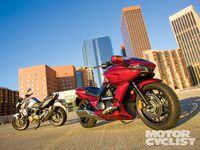
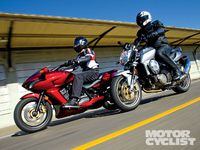

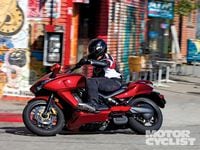

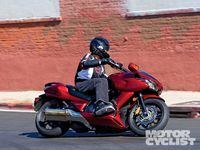
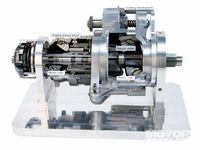

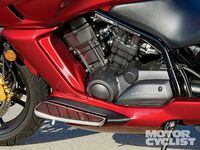


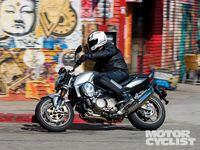
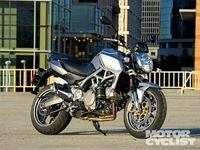
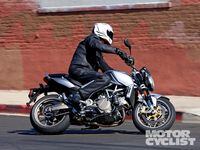
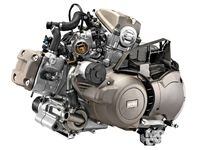
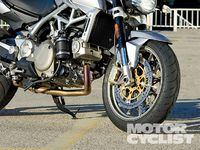

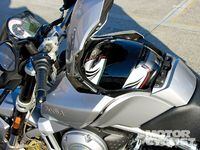

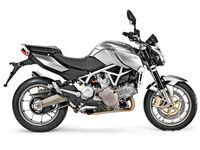
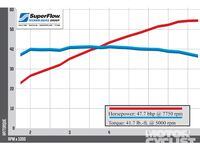






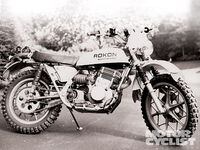
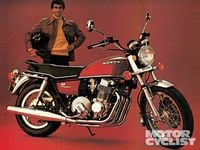
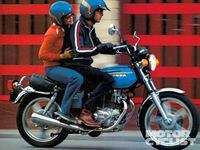
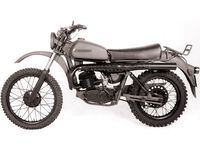

/cloudfront-us-east-1.images.arcpublishing.com/octane/G4MG6OUCJNBSHIS2MVVOTPX65E.jpg)
/cloudfront-us-east-1.images.arcpublishing.com/octane/IIGGWFOTOJGB7DB6DGBXCCMTDY.jpg)
/cloudfront-us-east-1.images.arcpublishing.com/octane/QSTCM6AVEZA5JJBUXNIQ3DSOF4.jpg)
/cloudfront-us-east-1.images.arcpublishing.com/octane/U4I7G625B5DMLF2DVIJDFZVV6M.jpg)
/cloudfront-us-east-1.images.arcpublishing.com/octane/B6XD6LS6IVCQPIU6HXDJSM3FHY.jpg)
/cloudfront-us-east-1.images.arcpublishing.com/octane/ICL63FEDDRDTTMINYICCEYGMDA.jpg)
/cloudfront-us-east-1.images.arcpublishing.com/octane/FCGZHQXRBZFLBAPC5SDIQLVF4I.jpg)
/cloudfront-us-east-1.images.arcpublishing.com/octane/WNOB6LDOIFFHJKPSVIWDYUGOPM.jpg)

/cloudfront-us-east-1.images.arcpublishing.com/octane/X33NU3E525ECRHXLNUJN2FTRKI.jpg)
/cloudfront-us-east-1.images.arcpublishing.com/octane/6KKT5NNL2JAVBOXMZYS5ZO76YA.jpg)
/cloudfront-us-east-1.images.arcpublishing.com/octane/J5RKG5O455GMPGQRF2OG6LRT7A.jpg)
/cloudfront-us-east-1.images.arcpublishing.com/octane/GX2CIZKQVRH2TATDM26KFG2DAE.jpg)
/cloudfront-us-east-1.images.arcpublishing.com/octane/ZWIDYSAKQZHD5BHREMQILXJCGM.jpg)
/cloudfront-us-east-1.images.arcpublishing.com/octane/CYUHJZCTSJCH3MRAQEIKXK7SCQ.jpg)
/cloudfront-us-east-1.images.arcpublishing.com/octane/LKOFINY56FCXJCANJ5M7ZDQUBY.jpg)
/cloudfront-us-east-1.images.arcpublishing.com/octane/4NBPDACMWJH63JQYJVK3QRBDZI.jpg)
/cloudfront-us-east-1.images.arcpublishing.com/octane/KKHQHRR3FJGX7H2IPU6RALMWG4.jpg)

/cloudfront-us-east-1.images.arcpublishing.com/octane/5IOFS5JAE5FOXMNA23ZRAVVYUU.jpg)
/cloudfront-us-east-1.images.arcpublishing.com/octane/CGXQ3O2VVJF7PGTYR3QICTLDLM.jpg)

/cloudfront-us-east-1.images.arcpublishing.com/octane/OQVCJOABCFC5NBEF2KIGRCV3XA.jpg)
/cloudfront-us-east-1.images.arcpublishing.com/octane/OPVQ7R4EFNCLRDPSQT4FBZCS2A.jpg)